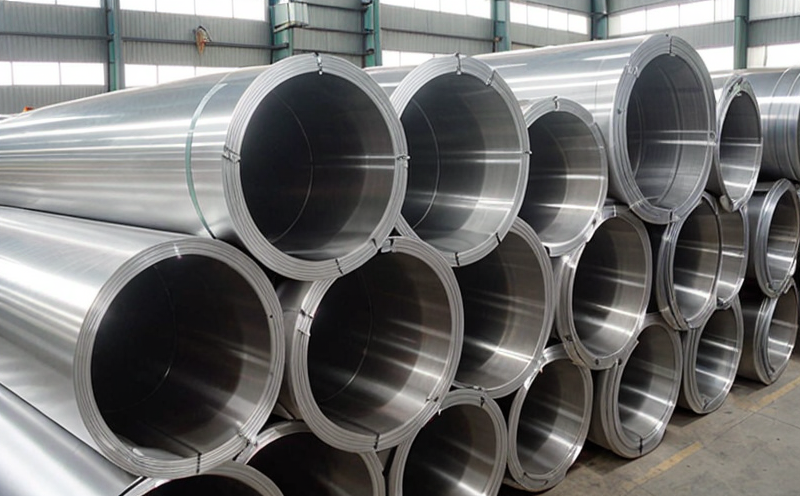IEC 60068-2-6 Sine Vibration Simulation Testing
The IEC 60068-2-6 sine vibration simulation test is a critical procedure used to evaluate the structural integrity and mechanical durability of components and assemblies made from various materials, including aluminium. This standard ensures that products can withstand environmental stresses without compromising their performance or reliability.
During this test, specimens are subjected to sinusoidal vibrations with controlled frequency, amplitude, and duration. The primary objective is to simulate the effects of vibratory loads encountered in real-world conditions, such as those experienced during transport or operation. For aluminium materials, which are widely used in marine equipment due to their strength-to-weight ratio and corrosion resistance, this test ensures that parts can perform reliably under dynamic loading.
The methodology involves setting up a vibration chamber where the specimen is placed on an isolator to mimic actual operating conditions accurately. The frequency range typically spans from 10 Hz to several kHz depending on the specific application. Amplitude levels are carefully selected based on industry standards and expected environmental exposure, ensuring that the test results reflect realistic performance under various stress scenarios.
The sine vibration simulation test plays a crucial role in quality control processes by identifying potential weaknesses early in development stages before costly failures occur during deployment or use. By adhering to this international standard (IEC 60068-2-6), manufacturers can demonstrate compliance with regulatory requirements and enhance customer confidence through proven durability.
For aluminium materials specifically, the test helps in assessing how these lightweight yet robust metals handle vibrations without compromising their integrity. This is particularly important for marine applications where equipment must endure harsh environmental conditions including saltwater exposure, high humidity levels, and varying temperatures.
The testing process involves precise calibration of vibration parameters to ensure accurate replication of real-world scenarios. Specimens are prepared according to industry best practices before being placed into the test chamber. Once testing is complete, detailed reports are generated outlining observed behaviors under simulated conditions, providing valuable insights for improvements or modifications if necessary.
Understanding the significance of this test is essential for quality managers and compliance officers responsible for ensuring product reliability across various industries, especially those involving high-stress environments like marine equipment manufacturing. R&D engineers can leverage these results to refine designs while procurement teams benefit from knowing that suppliers meet stringent testing protocols.
Scope and Methodology
The scope of IEC 60068-2-6 covers the application of sine vibration tests on various materials to determine their resistance against vibratory forces. This includes determining the fatigue strength, stability, and durability of components exposed to these conditions. For aluminium materials used in marine equipment testing, this method ensures that products can withstand harsh environmental factors such as saltwater exposure and varying temperatures.
Methodologically speaking, specimens are subjected to sinusoidal vibrations within a controlled environment. The test setup includes a vibration chamber where the specimen is mounted on an isolator to minimize external interference. Frequency ranges typically vary from 10 Hz up to several kHz, depending upon the specific application requirements. Amplitude levels are set according to predefined criteria aimed at replicating real-world stress conditions accurately.
During testing, the frequency and amplitude are systematically varied while monitoring specimen behavior using advanced instrumentation. Data points such as displacement, acceleration, and force are continuously recorded throughout the test duration. These measurements provide critical information about how well the material performs under specified vibratory loads.
After completing the sine vibration simulation test, a comprehensive report is generated detailing the results observed during testing. This document serves multiple purposes including providing evidence of compliance with relevant standards and offering valuable insights into potential improvements or modifications needed for better performance in future iterations.
Industry Applications
- Marine Equipment Manufacturing: Ensures that marine equipment, such as propellers, rudders, and hull components made from aluminium, can withstand the constant vibration encountered during sea voyages.
- Aerospace Industry: Validates structural integrity of aerospace parts like landing gear, wing assemblies, and engine mounts fabricated using lighter but stronger aluminium alloys.
- Automotive Sector: Tests automotive components such as exhaust systems, suspension arms, and brake calipers to ensure they perform reliably even when subjected to significant vibrations during vehicle operation.
Eurolab Advantages
At Eurolab, we pride ourselves on delivering top-tier services that meet the highest industry standards. Our expertise in marine and ship equipment testing ensures accurate results for your aluminium materials.
- Comprehensive Testing Capabilities: We offer a full range of tests tailored to different sectors including marine, aerospace, automotive, and more.
- State-of-the-Art Facilities: Our laboratories are equipped with cutting-edge equipment that guarantees precise measurements and reliable data collection.
- Experienced Professionals: Our team consists of highly skilled engineers who possess extensive knowledge in material science, mechanical engineering, and quality assurance.
- Comprehensive Reporting: We provide detailed reports that not only comply with international standards but also offer actionable recommendations for improvement based on test outcomes.





